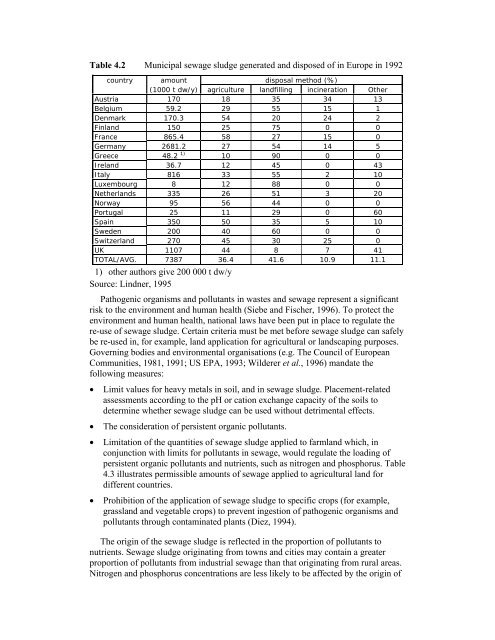Rolling Revision of the WHO Guidelines for Drinking-Water Quality ...
Rolling Revision of the WHO Guidelines for Drinking-Water Quality ...
Rolling Revision of the WHO Guidelines for Drinking-Water Quality ...
You also want an ePaper? Increase the reach of your titles
YUMPU automatically turns print PDFs into web optimized ePapers that Google loves.
Table 4.2 Municipal sewage sludge generated and disposed <strong>of</strong> in Europe in 1992<br />
country amount disposal method (%)<br />
(1000 t dw/y) agriculture landfilling incineration O<strong>the</strong>r<br />
Austria 170 18 35 34 13<br />
Belgium 59.2 29 55 15 1<br />
Denmark 170.3 54 20 24 2<br />
Finland 150 25 75 0 0<br />
France 865.4 58 27 15 0<br />
Germany 2681.2 27 54 14 5<br />
Greece 48.2 1) 10 90 0 0<br />
Ireland 36.7 12 45 0 43<br />
Italy 816 33 55 2 10<br />
Luxembourg 8 12 88 0 0<br />
Ne<strong>the</strong>rlands 335 26 51 3 20<br />
Norway 95 56 44 0 0<br />
Portugal 25 11 29 0 60<br />
Spain 350 50 35 5 10<br />
Sweden 200 40 60 0 0<br />
Switzerland 270 45 30 25 0<br />
UK 1107 44 8 7 41<br />
TOTAL/AVG. 7387 36.4 41.6 10.9 11.1<br />
1) o<strong>the</strong>r authors give 200 000 t dw/y<br />
Source: Lindner, 1995<br />
Pathogenic organisms and pollutants in wastes and sewage represent a significant<br />
risk to <strong>the</strong> environment and human health (Siebe and Fischer, 1996). To protect <strong>the</strong><br />
environment and human health, national laws have been put in place to regulate <strong>the</strong><br />
re-use <strong>of</strong> sewage sludge. Certain criteria must be met be<strong>for</strong>e sewage sludge can safely<br />
be re-used in, <strong>for</strong> example, land application <strong>for</strong> agricultural or landscaping purposes.<br />
Governing bodies and environmental organisations (e.g. The Council <strong>of</strong> European<br />
Communities, 1981, 1991; US EPA, 1993; Wilderer et al., 1996) mandate <strong>the</strong><br />
following measures:<br />
• Limit values <strong>for</strong> heavy metals in soil, and in sewage sludge. Placement-related<br />
assessments according to <strong>the</strong> pH or cation exchange capacity <strong>of</strong> <strong>the</strong> soils to<br />
determine whe<strong>the</strong>r sewage sludge can be used without detrimental effects.<br />
• The consideration <strong>of</strong> persistent organic pollutants.<br />
• Limitation <strong>of</strong> <strong>the</strong> quantities <strong>of</strong> sewage sludge applied to farmland which, in<br />
conjunction with limits <strong>for</strong> pollutants in sewage, would regulate <strong>the</strong> loading <strong>of</strong><br />
persistent organic pollutants and nutrients, such as nitrogen and phosphorus. Table<br />
4.3 illustrates permissible amounts <strong>of</strong> sewage applied to agricultural land <strong>for</strong><br />
different countries.<br />
• Prohibition <strong>of</strong> <strong>the</strong> application <strong>of</strong> sewage sludge to specific crops (<strong>for</strong> example,<br />
grassland and vegetable crops) to prevent ingestion <strong>of</strong> pathogenic organisms and<br />
pollutants through contaminated plants (Diez, 1994).<br />
The origin <strong>of</strong> <strong>the</strong> sewage sludge is reflected in <strong>the</strong> proportion <strong>of</strong> pollutants to<br />
nutrients. Sewage sludge originating from towns and cities may contain a greater<br />
proportion <strong>of</strong> pollutants from industrial sewage than that originating from rural areas.<br />
Nitrogen and phosphorus concentrations are less likely to be affected by <strong>the</strong> origin <strong>of</strong>

















